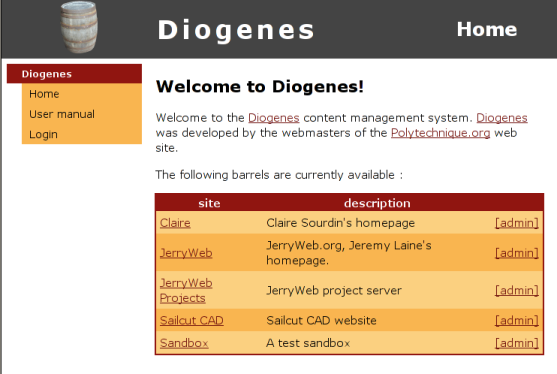Diogenes Documentation
- 1. Introduction : general Diogenes concepts
- 2. Installation guide : how to setup Diogenes on a web server
- 3. User manual : how to use Diogenes from the visitor point of view
- 4. Admin manual : how to create and manage a website with Diogenes
- 5. Root manual : how to manage a Diogenes server
1. Introduction
1.1. Diogenes and what it can do for you
Diogenes is a web content management system that allows you to create and manage multiple web sites on a single server via a web interface. It provides a sturdy authentication system with adjustable permission levels for each site and even for each page that makes up the site. Diogenes manages all the files that make up sites using revision control (you can choose between RCS and full-blown CVS), so the web sites can be managed collaboratively.
Diogenes was developped by Jeremy Lainé for Polytechnique.org, the non-profit organisation that manages Ecole polytechnique's alumni servers. Providing services both to individuals and to groups within the alumni community, it was realised that various alumni or student organisations need an easy-to-use (i.e for non programming-litterate people) web content management and hosting solution which gives them:
- a place to store their organisation's web site
- a web interface to manage the site's pages and menus
- an authentication and permission-level system to have different access levels for the various web pages
1.2 Levels of Access
The Diogenes user interface is split into several levels (which happen to correspond to the sections in this manual, more or less). This allows the manager of the server or individual barrels to delegate authority on some barrels or pages to others, without having to give the other user access to anything else.
The Ultimate Authority in a Diogenes installation is the Server Administrator. They have the ability to:
- Create, delete, and modify individual barrels in the system;
- Grant and revoke the ability to execute PHP code and create custom templates for individual barrels;
- Manage settings which affect the entire server (such as default templates, and what revision control system to use for files in barrels).
Since the server administrator can change the admins for each barrel, they in effect also have control over every barrel and page on the server, although it is common for the server administrator to manage very few barrels herself, and instead delegate that tasks to other people -- the barrel admins.
Each barrel has one or more Barrel Administrators. Anyone with administrative access to a barrel can:
- Change the name, description, keywords, etc, of their barrel;
- Set the default template for all pages in the barrel;
- Add and remove pages in the barrel;
- Change the stylesheets and menu for the barrel.
Sometimes, you only want someone to be able to modify some pages in a barrel, but not be able to add pages or change barrel-level settings. Diogenes supports this, by giving a user page admin access. Remember, also, that barrel and server administrators also have this privilege.
Page Administrators can:
- Add files to a page;
- Edit any of the files in a page, creating new revisions;
- Remove a file from the page;
- Change the title, template, and other settings of the page.
Finally, there are ordinary website users. If you do not want to give access to some of your pages to the Internet at large, you can create user accounts in Diogenes and give those users only read-only access to some parts of your barrel or server.
The details of performing the actions available to each level of administrator is detailed in the relevant section of the manual (which you can find in the menu to your left).
1.3. The toplevel site
The Diogenes toplevel site is the main entry point to all the barrels. It also provides server administrators with tools to handle server-wide operations like managing user accounts, creating and deleting barrels.

1.4. Diogenes, barrels et al.
You might be wondering why a web content management system is called Diogenes. Diogenes of Sinope was a Cynic philosopher who was born in Sinope, an Ionian colony on the Black Sea. One of the most famous anecdotes about his lifestyle is that he took up residence in a barrel (more acurately a pithos, or large tub).
The web sites created using the Diogenes content management system are referred to as barrels, because they are self-contained, each barrel having its own own separate content and permissions. All operations related to content and permissions are done at the barrel level.
$Id: page.html,v 1.4 2004/06/19 01:12:45 matthew.palmer Exp $